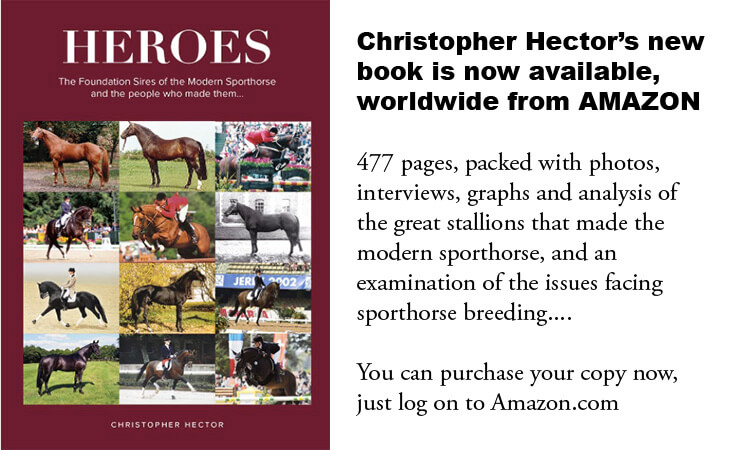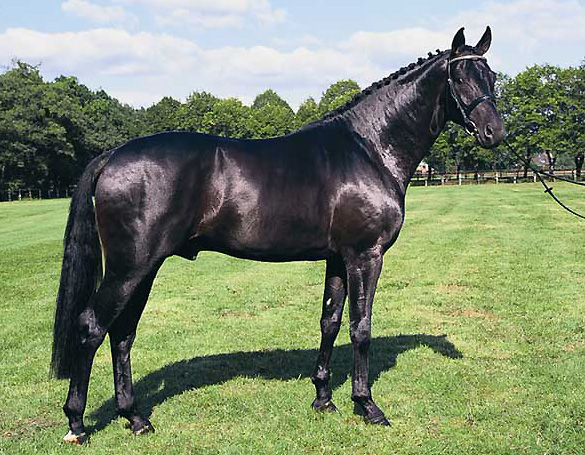
Christopher Hector assesses the career and influence of the stallion, Sandro Hit (1993 – 2021) Image Werner Ernst
Most of the important stallions are considered important because of the progeny they produced, but Sandro Hit’s influence is on the whole shape and nature of sporthorse breeding in Germany. It’s influence like no other horse has had…
He was the number one stallion on the 2021 WBFSH dressage stallions rankings, but perhaps his influence on the world of Warmblood breeding has been less in the sphere of genetics, and more in the world of commerce, since it was Sandro Hit who initiated the establishment of the Paul Schockemöhle stallion station, the first step in a development that today sees Schockemöhle – teamed now with the Dane, Andreas Helgstrand – breeding director of what is the de facto German National Stud, a dominating influence in sporthorse breeding all over the world…
The black stallion was lucky to make it to the breeding barn. He was the jumping-bred colt, who wasn’t much of a jumper, yet as the rider who ‘made’ him, Ulf Möller told me, he found his way to fame.
Here was a stallion that had done a poor performance test, he was not bred for dressage, but you saw something there and ended up with a World Dressage Champion, and now it seems a champion sire?
“Maybe that has something to do with the test at the time. Now they don’t have to do that 100 day test and I think that is very good decision. Some stallions are too weak to do a 100 day test, and to do all those things like cross country jumping. Now we have a 30 day test and then it goes on their competition record, that is much better for the future. Okay he might be bred like a jumper, but he cannot jump. He makes a nice jump but he has no scope.”
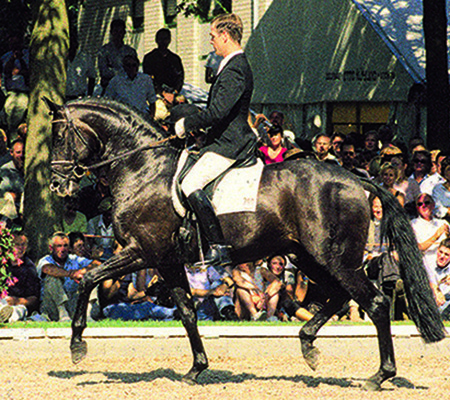
With Ulf in the saddle, Sandro Hit dominated the 6-y-o Dressage Championship at the 1999 Bundeschampionate. His presence and charisma were overwhelming, and, with Ulf, he found a showman who knew exactly how to conserve his horse to produce the big performance right on cue. They were also World Young Dressage Horse Champions at Arnheim that same year before the black stallion retired to a sensational stud career.
I’ll really never forget, turning the corner and looking down the Bundeschampionate warm up arena in 1999, and seeing this vision of black elegant power across the diagonal… it was little surprise that mare owners flocked to him, and that’s when we see the other twist, the growth of the Schockemöhle mega stallion station:
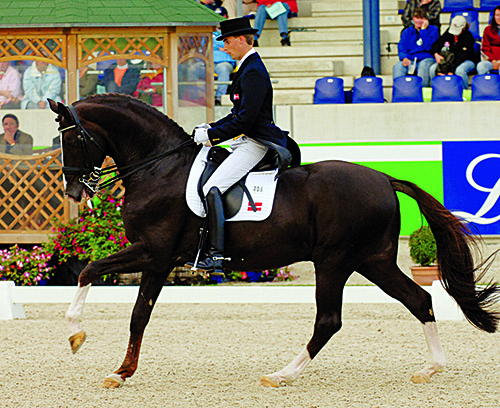
Don Schufro – a good offer so he was sold…
Again, let Ulf tell the tale: “Sandro Hit was the stallion that gave Paul Schockemöhle the idea to run the breeding stud seriously. Before he had owned Don Schufro, but then he got a good offer, and sold him. That was his idea before – he had good stallions, but if he had a good offer – whoosh – they were gone. Sandro Hit was the first stallion where he got a really really big offer and said, no, I keep him. Then it worked, and gave him the idea that it is worth keeping the good stallions for a while and then to decide what to do – because it is a business, it is not a state stud supported by the government. At the moment I think we can offer every breeder in the world, a stallion for his special mare, because we have such a variety of stallions.” And really that was just the beginning, now the choice is positively encyclopaedic.
Sandro Hit was by Sandro Song (a 1.20m jumper and medium dressage competitor) who was by the half-blood Holsteiner, Sandro (a 1.60m jumper), out of a mare by the Gotthard son Gepard. He was the first male foal from Loretta (Ramino / Welt As), her next colt, Diamond Hit (Don Schufro) was an elite Grand Prix competitor, and a fine sire, indeed, Paul Schockemöhle told me he thought Diamond Hit was the better of the two sons.
Right from the start, Sandro Hit was a controversial figure, there were even those who added the letter S to his suffix. Prominent Westfalien breeder, Stefan Borgmann told me in 2014, “We have 100 horses and not one with the blood of Sandro Hit… no Sandro Hit, no Sir Donnerhall, no San Amour, no Show Star… and in the future I can advertise – no Sandro Hit here!”
As might have been predicted, Sandro Hit’s early success in the Young Horse classes, and the boom in these classes that followed was in no small part a result of the ‘buzz’ that flowed from Sandro Hit’s own performances.
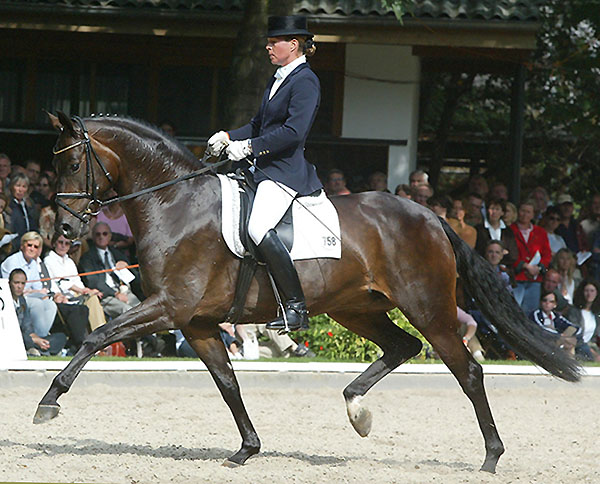
Poetin, out of Poesie, and a World Champion… Here winning at the Bundeschampionate
The first cross that really worked was with the mare – Poesie – based at Neustadt-Dosse, the Brandenburger Stud in the former East Germany. She was by that great broodmare sire, Brentano, and bred to Sandro Hit produced first the World Young Dressage Horse Champion Poetin, followed by the three Samba Hit brothers – all of who starred in young horses classes and each year the Bundeschampionate became a showcase for the Sandro Hits.
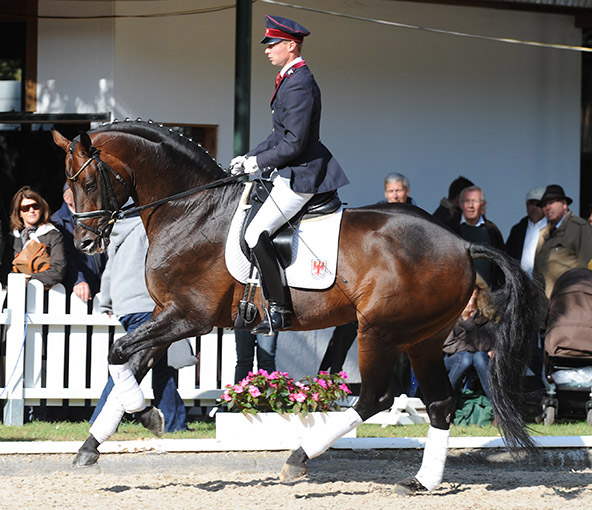
And one of the Samba Hit brothers, also a Bundeschampion….
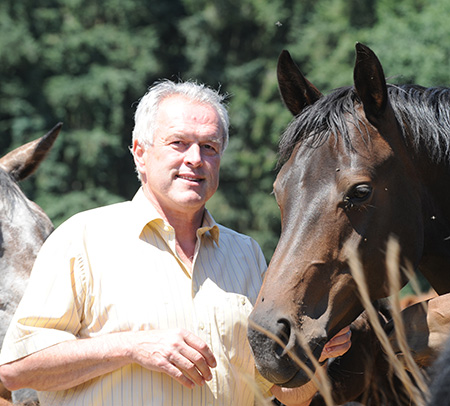
The director of the Brandenburg Stud, Dr Müller was early to use, Sandro Hit, but by 2005 had come to a more considered assessment of the stallion:
“Poetin was born in 1997, and at this time, I think Sandro Hit was a good thing, but now Sandro Hit is in the second and third generation, and I think that is enough – I don’t think we need him now. The offspring are difficult to ride, but we have a very good mother line. Sandro Hit was a bit crazy, but we have a filter, our mother line is very good in its temperament… At the time Sandro Hit was a good combination with our mares, but that was ten years ago, and now we have other good stallions, and we need horses with a good rideability, three good gaits – especially walk. And with Sandro Hit we never have a good walk!”
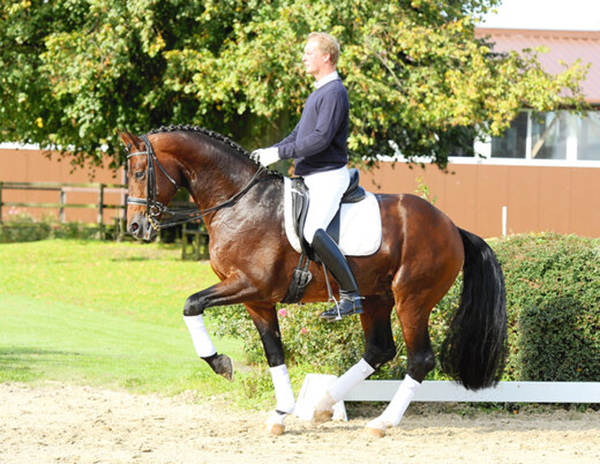
Ingo Pape and Scolari
Leading German stallion keeper, Ingo Pape, is a fan. His senior stallion, Scolari (Sandro Hit / De Niro / Weltmeyer) himself a Grand Prix competitor has produced 335 competitors including 21 at S level. Two more of Ingo’s current stallion band, VPlus and Venido carry Sandro Hit’s blood on the mare line.
I asked Ingo what he thought Sandro Hit brought to the equation…
“He brings the beauty and the nice front part of the horse, shoulder length, beautiful top-lines, good canter work, and good trot work, a very open shoulder freedom, dark colours – a very, very commercial horse.”
These qualities outweigh the fact that he sometimes brings a very bad walk, and a tendency to be out behind?
“The walk and the hind legs in the trot, are not his highlights that’s clear, but the question then, is how you cross that line, if you cross it with a solid walk and a powerful loin and a quick hind end, then you get wonderful horses. He was highly criticised from the beginning for several things, but he was always used a lot and given a big chance by the breeders, and there are so many successful horses in the sport that now maybe the criticizing people have to reverse the things they said. Right from the start I was told you can never ride them, and I’ve never, never, never had that experience, and I’ve ridden a lot of them. I never agreed with that opinion.”
Most of us thought that he would be a good sire of young horse competitors, but he has been a good sire of Grand Prix horses, did you expect that?
“That is not something you can really expect I think. Okay he has this beautiful canter work, which he really gives to his offspring, and you simply have to wait to see how the dynamic of the hind leg is coming through when you go towards piaffe, passage. He is not coming out of a line which is so proven in producing dressage horses, when you look at the first few lines of the pedigree, you think more about a jumping horse, so you could not be sure that he would produce Grand Prix dressage horses, but he did, he really did.”
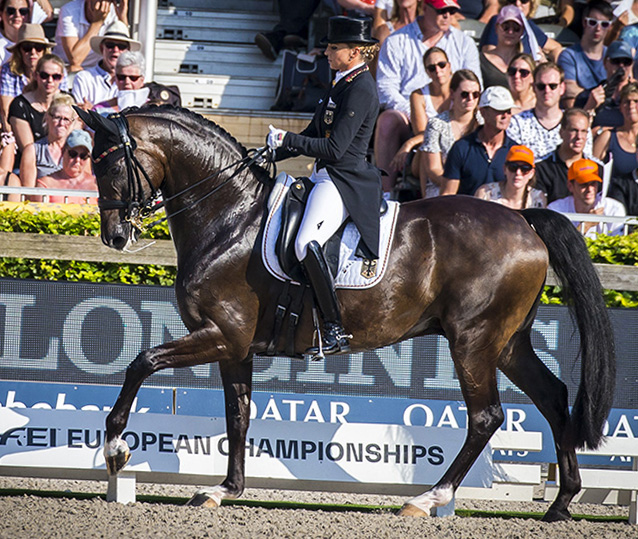
Dorothee Schneider and one of her successful Sandro Hits, Showtime, at the Europeans: Rebecca Ashton image
While there were plenty of us, who sat back and said, oh yes, but he will never produce Grand Prix horses, we were wrong, very wrong. The 2022 Hanoverian Stallion Book, records that he is the sire of 1297 competition horses with winnings of €1,619,611, with 213 of them competing at S level, 200 at S*, 90 at S**, 61 at S***, 21 at S****, and even three at five-star level. Twenty of his offspring have won more that €10,000 in prizemoney – the most successful being the Olympic stars, Showtime FRH (€245,895) and Salvino (€ca80,000).
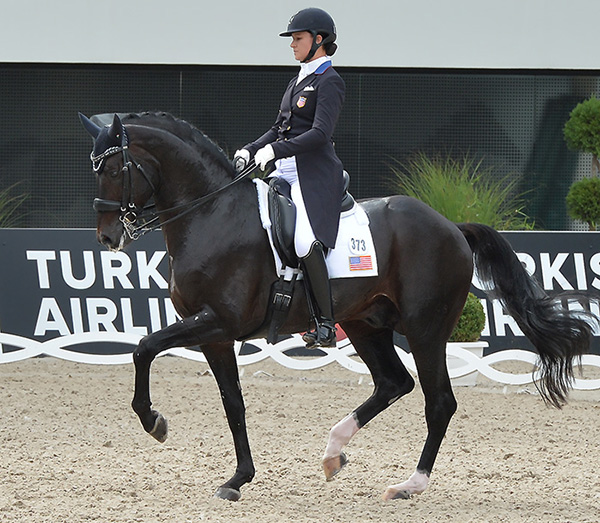
Salvino and Adrienne Lyle
His FEI breeding value as a sire of young horse competitors is 127, but he has a value of 156 for highest level achieved.
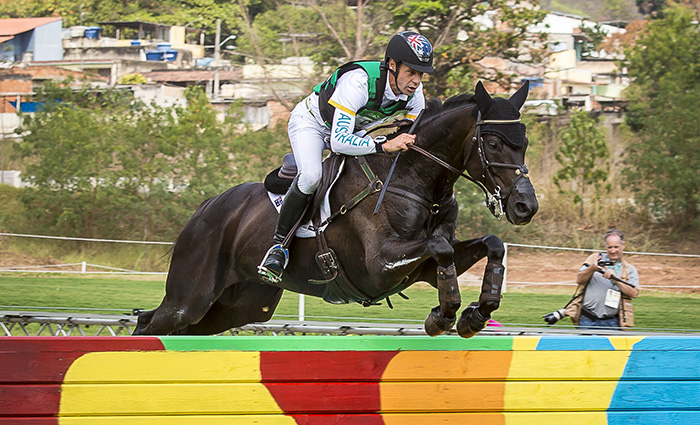
There’s even a Olympic Medal winning eventer! Christopher Burton’s Santano – a Bronze for Australia at Rio
Sandro Hit also changed the breeding aim for many mare owners. Some of them who went to Sandro Hit, found even the wait for the young horse classes tiresome, and suddenly the foal auction boom was in full swing. The breeders were aiming not for a place in the Elite Riding Auctions for three and four year old horses, but to sell their foals at auction while they were still foals, and they are getting good prices. I put it to Ulf Möller that this development has worrying implications for the breeding program…
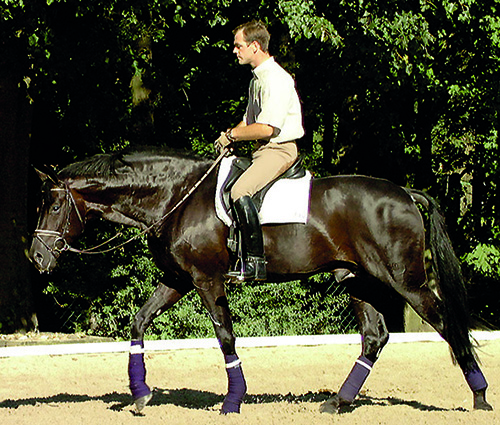
Ulf said of the stallion as a young horse: “Remember Sandro Hit is my friend…”
Is it a problem that breeders are breeding for foals because of the big prices at the foal auctions – and there the money is for the foal with extravagant front legs, but maybe a little hollow in the back and when it grows up, not the nicest horse to ride?
“The whole breeding character has changed in Germany. I often talk to breeders about this. Years ago, the children of the breeders were riding the product for one year, to show them a little bit. And this saved money because it is not so expensive. Now I think half the breeders have no background in agriculture, if they have a three-year-old horse they have to give it to a trainer, and this is hundreds of Euros a month. That means after five or six months, you have a horse that is nicely broken in, but it cost you a lot, and still, if it is not top quality, it is too young to sell to an amateur. Once you put a saddle on the horse, the cost goes uphill quickly… with Sandro Hit, you can sell the foals very easily because they are very nice as foals. That’s why he will be there for as long as he lives because he gives you nearly a guarantee for the colour, for uphill movement and for a nice neck. As long as the breeders can get good money – and I don’t mean one hundred thousand – I mean a good price, then they use him.”
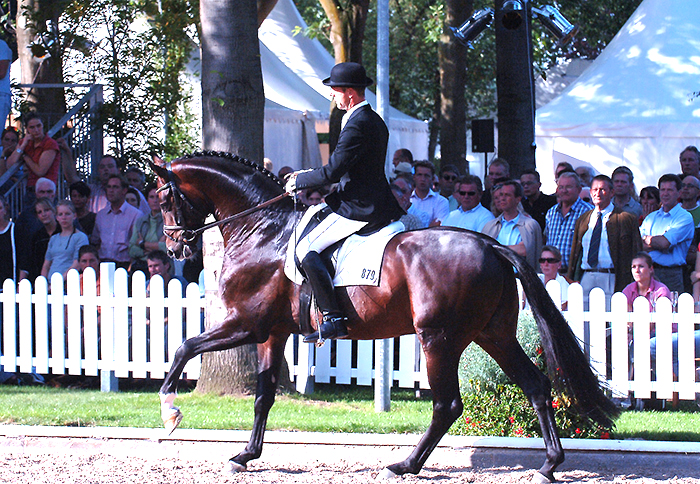
Sir Donnerhall and Ulf, winners at the Bundeschampionate
Sandro Hit has also been a prolific sire of stallion sons. On the latest WBFSH dressage stallion rankings, Sandro Hit is joined by his son, Sir Donnerhall I (Donnerhall) in 4th position, Spielberg (by the Sandro Hit son, Sunny-Boy) is eighth, while San Amour I (Plaisir d’Amour) is 20th, and San Remo (Samba Hit I out of a Rubinstein Noir mare) comes in at 21st.
Right now, especially after the most recent ‘worlds’ in Ermelo, the buzz is on the 11-y-o Sandro Hit great-grandson, Blue Hors St Schufro, who was recently crowned a Danish Elite stallion.
St Schufro is by St Moritz Junior by St Moritz (Sandro Hit / De Niro) out of Wie Princess (by Wie Weltmeyer) out of a Prince Thatch xx mare. Not surprisingly, St Schufro is out of a mare by Don Schufro, out of an Atatuek mare.
St Schufro was the premium stallion at the 2013 Hanoverian licensing. Not immediately popular, St Schufro’s demand has increased steadily with a big boost in the form of the 5-y-o World Champion, Lyngbergs St Paris, one of the four by St Schufro to qualify for Ermelo. He was also the sire of the four year old winner, St Athletique, and the four year old Swedish champion, Skyline To B.
St Schufro’s standing has been further enhanced since he commenced a Grand Prix career in 2022 with Nanna Merrald Rasmussen, with a Nations Cup victory in Falsterbo and second place in his first World Cup appearance in Vilhelmsborg and he is shaping as Nana’s choice for the 2023 European Championships.
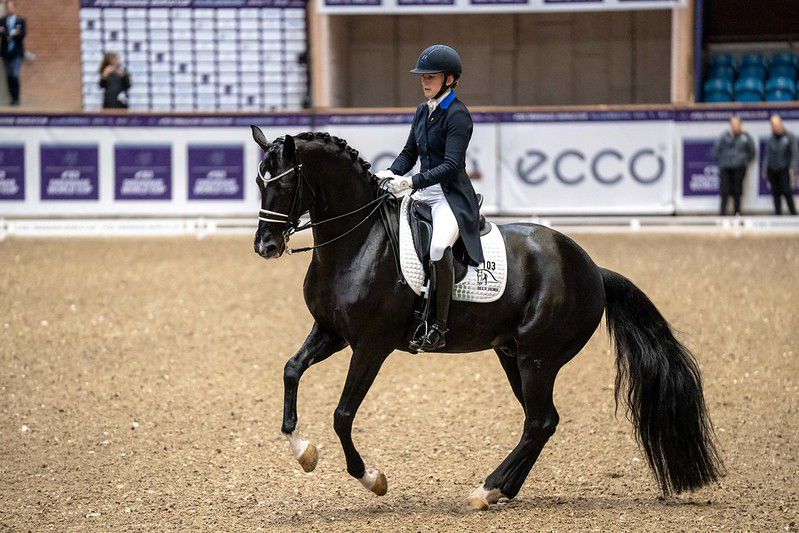
St Schufro and Nanna Merrald Rasmussen (Photo – Kim C Lundin)
Sandro Hit, and other successful carriers of his bloodlines are available to Australian breeders from International Horse Breeders – go to www.ihb.com.au
